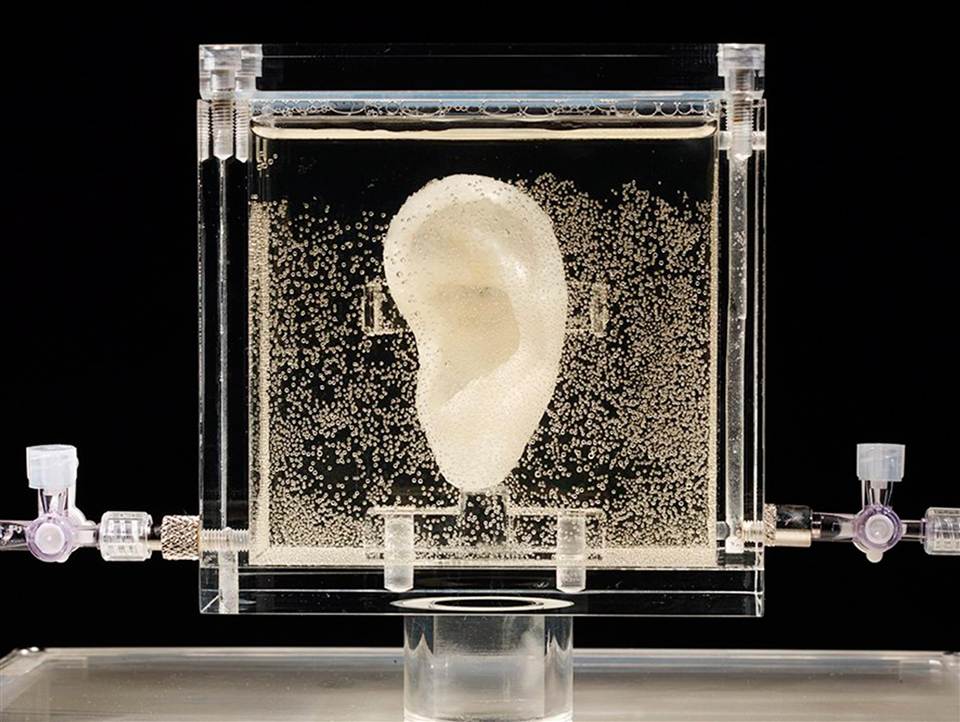We have already seen numerous human tissues 3D printed in a process which has been call 3D bioprinting. Such technology promises to, in the long run, cure many ailments, regrow faulty organs for implantation, and  eventually allow for all sorts of ‘replacement’ body parts.
eventually allow for all sorts of ‘replacement’ body parts.
One American based artist, Diemut Strebe, has teamed with scientists to produce what may be one of the craziest pieces of art we have ever seen. Strebe has 3D printed the severed ear of late painter Vincent van Gogh. Most of you reading this probably figure that the ear was somehow printed out of plastic, like most of the other 3D prints you have seen in the past. However, this ear was actually printed using real living human cells from, Lieuwe van Gogh, the famous painter’s great-grandson, who shares 1/16th of the same genes as the 19th century icon. The original plan was to use actual DNA, extracted from an envelope that Vincent Van Gogh had licked, but the DNA turned out not to be his.
“I use science basically like a type of brush, like Vincent used paint,” stated Diemut Strebe, the piece’s creator.
The famous ear was chopped off by van Gogh himself, and delivered to a brothel in which he was a regular at. This took place in 1888, two years prior to his death in 1890. Using a sophisticated 3D bioprinter, and computer software, Strebe was able to actually print the cells in a shape that resembles the painter’s actual ear. Once the cells were printed, the ear was grown at Boston’s Brigham and Women’s Hospital.
Believe it or not, the ear is technically alive, as it is made out of living human cells, which have been formed into cartilage. If that isn’t impressive enough it can also ‘hear’ as well.
The ZKM | Media Museum website states that “You can talk to the ear. The input sound is processed by a computer using software that converts it to simulate nerve impulses in real time. The speaker remains in soliloquy. The crackling sound that is produced is used to outline absence instead of presence.”
The ear will be on display on the ground floor of the ZKM | Media Museum in Germany until July 6th of this year. The ear can theoretically be kept alive for years because of the nutrient solution which feeds its cells. Diemut Strebe, who is represented by the Feldman Gallery, plans to showcase her art in New York City next spring. Whether this ear will be on display or not, we are not certain.
What do you guys think about this incredible piece of work? Let us know in the ‘3D printed Van Gogh ear‘ forum thread at 3DPB.com
[Image Source: Associated Press]Subscribe to Our Email Newsletter
Stay up-to-date on all the latest news from the 3D printing industry and receive information and offers from third party vendors.
Print Services
Upload your 3D Models and get them printed quickly and efficiently.
You May Also Like
Reinventing Reindustrialization: Why NAVWAR Project Manager Spencer Koroly Invented a Made-in-America 3D Printer
It has become virtually impossible to regularly follow additive manufacturing (AM) industry news and not stumble across the term “defense industrial base” (DIB), a concept encompassing all the many diverse...
Inside The Barnes Global Advisors’ Vision for a Stronger AM Ecosystem
As additive manufacturing (AM) continues to revolutionize the industrial landscape, Pittsburgh-based consultancy The Barnes Global Advisors (TBGA) is helping shape what that future looks like. As the largest independent AM...
Ruggedized: How USMC Innovation Officer Matt Pine Navigates 3D Printing in the Military
Disclaimer: Matt Pine’s views are not the views of the Department of Defense nor the U.S. Marine Corps Throughout this decade thus far, the military’s adoption of additive manufacturing (AM)...
U.S. Congress Calls Out 3D Printing in Proposal for Commercial Reserve Manufacturing Network
Last week, the U.S. House of Representatives’ Appropriations Committee moved the FY 2026 defense bill forward to the House floor. Included in the legislation is a $131 million proposal for...


































